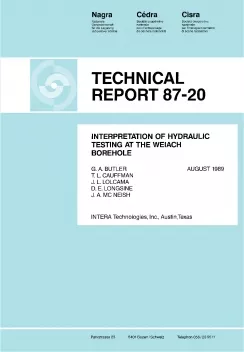
Technical Report NTB 87-20
Interpretation of hydraulic testing at the Weiach borehole
This report presents the results of hydrogeologic interpretations of all analyzable single packer, double packer, and H-log tests conducted in the Weiach borehole. Ten of the 37 technically successful tests were conducted using a single packer configuration. One test of the Upper Muschelkalk was configured using temporary casing with an external casing packer to conduct a drawdown-recovery test in the isolated zone. Twenty-six intervals were tested using a double packer configuration. Nineteen of these intervals were tested using a hydraulic test tool (HTT). Seven of these intervals were tested using a drill-stem test (DST) tool and drill-stem test methods and one test was completed with a DST tool used to isolate the test interval for a pumping sequence. Three H-log tests were completed near the bottom of the borehole with the HTT and double packer configuration. All the tests were completed with one or more of the following test methodologies at each test interval: slug tests, pulse tests, drill-stem tests (DST) and pumping tests. The tests discussed in this report cover the section of the borehole from apparent depth (along the borehole length) of 188.0 m to the bottom of the borehole at 2482.2 m. The testing occurred within the Malm, Dogger, Lias, Keuper, Muschelkalk, Buntsandstein, Perm, Karbon, and Crystalline Groups. A discussion of the testing and interpretation methods is presented. Data analysis was performed using the INTERA Graph Theoretic Field Model (GTFM) which permits borehole pressure history and thermally-induced pressure effects to be incorporated into the simulations, and Horner graphical techniques.
Formation pressures (and corresponding equivalent freshwater heads) were determined for two test intervals where the formation had a relatively high hydraulic conductivity. The calculated equivalent freshwater heads were 412.6 and 452.6 m asl at depths in the sedimentary portion of the borehole of 984.2 m and 1117.5 m, respectively. The surface datum elevation is 368.66 m asl. Borehole pressure history, thermal effects, or poor data records prevented determination of formation pressures (and corresponding equivalent freshwater heads) in the remaining sections of the borehole.
Hydraulic conductivities were estimated for 36 of 37 tested intervals, and specified with recommended values for 30 intervals, covering the crystalline rock portion of the Weiach borehole and describing every sedimentary formation mentioned above. Interpreted hydraulic conductivities ranged from 1.0E-06 to 3.0E-13 m s-1. Zones of high hydraulic conductivity (greater than 1.0E-08 m s-1) were obtained for 4 zones corresponding to the following apparent depths: 188 m – 267 m (MaIm), 822 m – 896 m (Muschelkalk), 981 m – 990 m (Muschelkalk – Buntsandstein), and 1109 m – 1247 m (Perm). An estimate of the uncertainty in the reported hydraulic conductivity of each zone is given based on a sensitivity study in specific storage. Simulations were completed at a base case specific storage and also at a specific storage one order of magnitude above and below this value. Hydraulic conductivity of the formation was determined from each simulation and reported together with the best-fit value to provide a reasonable range of hydraulic conductivity for the zone.
Simulations of the measured pressures resulted in estimates of specific storage for each interval. Specific storage ranged in value from 6.2E-05 to 2.1E-07 m-1.
The measured temperature in the borehole during hydraulic tests ranged from about 27°C to 88°C in the sedimentary section and 96°C to 114°C in the crystalline section. A more accurate temperature profile for the formations at Weiach, to a depth of about 2400 m, was determined by examining High Resolution Thermometer (HRT) logs and Auxiliary Mud Resistivity (AMS) logs and comparing these temperatures with hydraulic test temperatures. Temperatures measured using HRT and AMS logging in early 1985 appear to represent undisturbed formation temperatures. The thermal gradient in the borehole from this data appears to be 4.7°C/100 m.
Hydraulic test interpretations of the Weiach borehole were complicated by special problems, the most significant of which were high borehole temperatures at depth, poor packer seating, and uncertain borehole pressure history. The thermal related problems manifested mostly as packer failure and transducer failure. In the cases where these effects added significant uncertainty to the interpretation, an estimate of the uncertainty was attempted.
